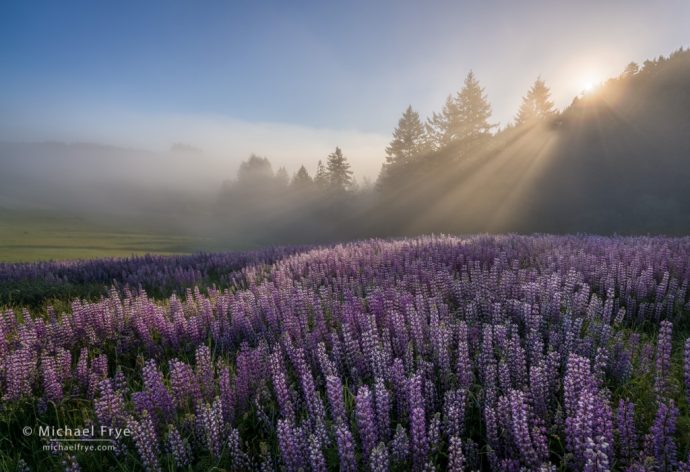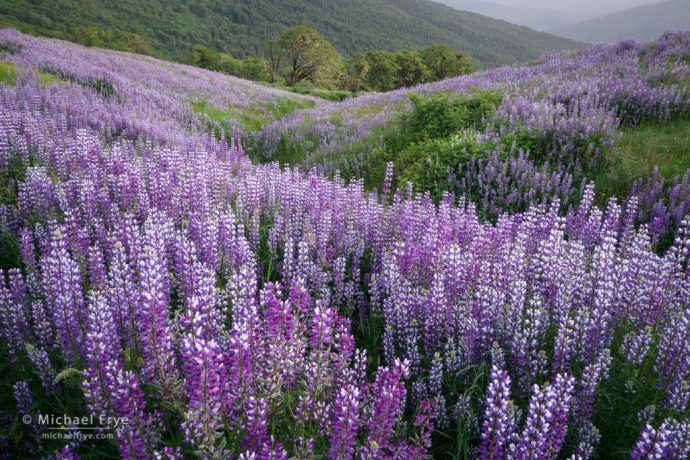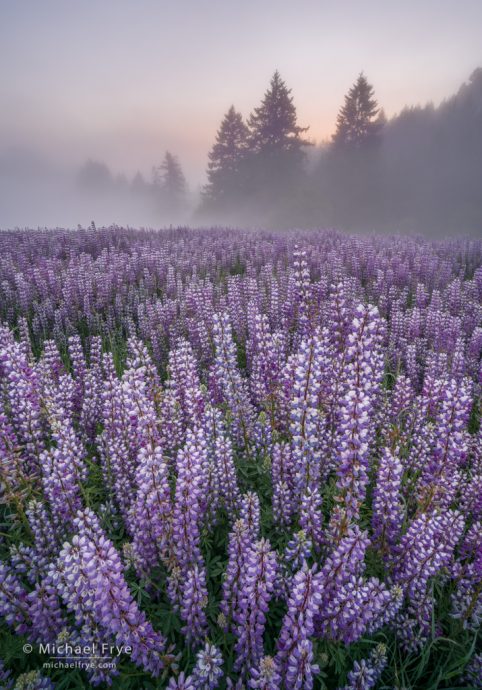
Sun rising over a field of lupines, Redwood NP. I put the sun behind a tree to reduce flare, and bracketed five frames, two stops apart, then blended the exposures using Lightroom’s HDR Merge. (16mm, f/16, various shutter speeds, ISO 100.)
Before our recent redwoods workshop Claudia and I drove inland, toward the higher elevations of Redwoods National Park, and found a beautiful, dense patch of lupines in one of the “prairies,” as they call them in that part of California – an open, grassy area amid the dense surrounding forests. We also found some photographer friends there, Terry Donnelly and Mary Liz Austin, and met two other photographers, Ed Callaert and Bruce Jackson. It’s amazing how you meet photographers in the most out-of-the-way – yet beautiful – places.
On that first afternoon the light wasn’t particularly special, but I did manage to make one image I liked (the first one below) in soft light after the sun set. Two days later, in Crescent City, we woke early and saw a high fog bank, or marine layer, and thought maybe we might see fog among the lupines. Claudia and I arrived about 15 minutes before sunrise, and the lupines were right at the top of the fog bank, which was perfect, creating an opportunity to photograph sun, fog, and lupines together.
The grasses were soaking wet, so I put on rain pants and waterproof boots. It didn’t take long for the moisture to seep into my socks anyway, but I paid little attention, as the sunrise was starting to color the fog, and there were lupines waiting to have their picture taken. Claudia and I were alone for a little while, but soon Terry, Mary, Ed, and Bruce arrived, and we all photographed the lupines as the sun came up over the trees and lit the fog and flowers. We even had sunbeams for a short time.
All my images shown here were made with a wide-angle lens (Sony 16-35 f/4), which is unusual for me. But the lupines weren’t mixed with other flowers, and therefore didn’t lend themselves readily to tight views focused on patterns of flowers. Also, the lupines were tall, so in most cases you had to get up close to see over the flowers to the trees (and sometimes fog) beyond. That required using a wide-angle lens and pointing the camera down to try to fill the foreground with flowers. Being so close to the lupines also meant that the exact camera position (including height) was important. In each of these compositions I tried to put the camera in front of a thick patch of flowers, and find an interesting pattern among the color.
Unfortunately the lupines were past peak by the time our workshop started, but I’m glad I was able to catch some moments of fog, light, and flowers while they lasted. It’s been a great spring; we’ve photographed the amazing bloom in the Carrizo Plain, dogwoods in Yosemite, and then lupines and rhododendrons in the redwood country. And I’m hoping to photograph more wildflowers in the Yosemite high country this summer.
— Michael Frye
Related Posts: The Primeval Coast; The Painted Hills
Michael Frye is a professional photographer specializing in landscapes and nature. He is the author or principal photographer of The Photographer’s Guide to Yosemite, Yosemite Meditations, Yosemite Meditations for Women, Yosemite Meditations for Adventurers, and Digital Landscape Photography: In the Footsteps of Ansel Adams and the Great Masters. He has also written three eBooks: Light & Land: Landscapes in the Digital Darkroom, Exposure for Outdoor Photography, and Landscapes in Lightroom: The Essential Step-by-Step Guide. Michael has written numerous magazine articles on the art and technique of photography, and his images have been published in over thirty countries around the world. Michael has lived either in or near Yosemite National Park since 1983, currently residing just outside the park in Mariposa, California.











Michael, that last one takes my breath away!
Thanks Monika!
Thank you for not over processing the HDR. These look very natural and realistic.
Well I try not to over-process things – thanks. Lightroom’s HDR Merge does a good job of making natural-looking HDR images. So it’s a great tool if that’s what you’re looking for, but not the best tool if you want that “HDR look.”
awesome. I am sure the pattern of the flowers is what causes the almost moire type effect, but I was wondering when you merge so many shots how much of a problem does movement from the wind cause when trying to align so many blooms?
Thanks Kanwarjit. Movement can be a big problem when merging images, but there was no wind in this instance.
Michael, Wonderful Images! But I’m a little confused—when you say you bracket 5 exposures 2 stops apart do you mean 2 stops total, which would be a half stop difference with each successive exposure in the bracket; or do you mean 5 exposures with each exposure 2 stops different from the previous frame?
Thanks Brad. I meant that each exposure was two stops different from the previous frame. Half-stop increments are too small; one to two stops is best for an HDR merge.
One of the most powerful images of Lupines I have
seen to date!
Thank you Ed!
Each image is absolutely stunning but my favorite is the last image-the vertical with purple hued trees–OUTSTANDING!!
as always –thanks for sharing your techniques and inspiring all of your followers to get out and shoot!
Thanks very much Donna – glad you like that photo!
Lupines and fog? What a treat!
Thank you Vivienne!
Beautiful!
Thanks Tami!
Hi Michael,
You continue to outdo yourself. Fantastic photos, particularly the one at sunrise!
What’s the word on wildflowers in Tuolumne Meadows at the moment?
Cheers,
Alyn
Thanks Alyn! Tioga Road just opened on Thursday, and I haven’t been up there yet. I’d guess that Tuolumne Meadows is mostly underwater right now, so it’ll be awhile before there are flowers there. And it hasn’t really been a great wildflower area for at least 25 years.
Michael,
Thanks much!
As to your upcoming, high-country photo workshop soon to come, have a great adventure.
Cheers,
Alyn
You sure are dedicated and determined to get the shot. It just shows how important planning and patience are in creating beautiful artistic images like these.
With five shot HDR it’s.amasing the flowers arn’t blurred with the wind.
I have nothing but respect for your work and eternally great full for the privalidge of seeing them.
Thanks very much Barry! None of these are HDR images; all are just one exposure. While I do bracket and blend exposures sometimes in high-contrast situations, that’s rather rare, and the vast majority of images I post are single exposures. Here, the fog actually made all these scenes quite low in contrast, so there was no need for bracketing. I did try focus-stacking in some situations, but the wind made that problematic, so I tried to get everything in focus without focus-stacking, and none of these images were focus-stacked.